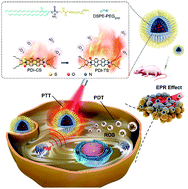Regioisomer-manipulating thio-perylenediimide nanoagents for photothermal/photodynamic theranostics†
Abstract
Thionated perylenediimides (PDIs) can potentially generate thermal and reactive oxygen species and thus can be used as theranostic agents for photothermal/photodynamic therapy. Herein, thionated cis-/trans-isomer PDI-CS and PDI-TS were designed and prepared to investigate thionation engineering on therapeutic performance. The results revealed that the photodynamic performance is less associated with the positon of sulfur atoms. By contrast, trans-isomer PDI-TS showed a photothermal conversion efficiency of up to 58.4%, which was 40% higher than that of PDI-CS (∼41.6%). An in vitro half-maximal inhibitory concentration of ∼7.78 μg mL−1 was achieved for PDI-TS, which was 1.7-fold smaller than that of PDI-CS, strongly reasserting the regioisomer-modulated phototheranostic performance. Notably, the strong π–π and C⋯S interactions in PDI-TS nanoagents are essential factors attributed to their excellent photothermal performance, indicating that the optimization of non-bonding interactions is an ingenious way to improve phototheranostic performance. This work provides a facile means of creating thio-perylenediimides that possess excellent antitumor properties and a novel proof of concept to improve therapeutic performance through the optimization of non-bonding interactions.



 Please wait while we load your content...
Please wait while we load your content...